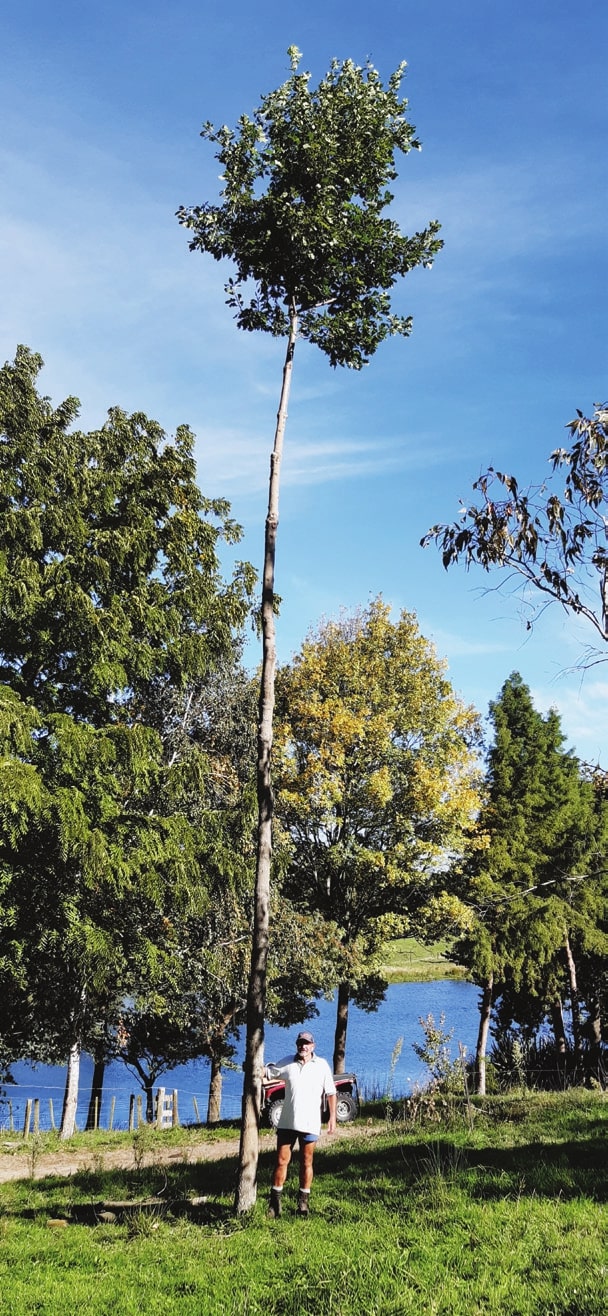Oak Action Group red oak trials
Eric Cairns, Rachel Rose and Kees Weytmans, New Zealand Tree Grower May 2021.
The aim of this study is to demonstrate the growth and timber potential of seven deciduous red oak species on trust-administered land at Eastwoodhill and Rewanui. The red oaks for this trial series will be Quercus ellipsoidalis, Q. kelloggii, Q. pagoda, Q. palustris, Q. shumardii, Q. rubra and Q. texana (aka Buckley/nuttallii) along with hybrids of these species. These all have a reputation for good timber and the proposal is to plant a hectare at each site with elite seedlings.
Appletons Nursery will supply the oak trees, selected as best growers from their nursery lines, which will be cluster planted and thinned to the best performer in each cluster. Hybrids of the above species are included as this represents a significant opportunity for enhanced growth given the quite limited range of genetic resource for red oaks in New Zealand.
Management for 40 years
The trial trees will be maintained twice annually for the first five years, then annually until pruned butt heights of 6.5 metres are achieved. Diameter increments will be recorded periodically from year five onwards. Retained trees will be selected for vigour, health and diameter of the butt log. It is anticipated that diameter increments averaging at least two centimetres a year will be achieved for most of the final crop trees.
The trials are scheduled to last at least 40 years, but may be longer. It is expected that at the end of the trial, or when trees are deemed mature enough, that at least some trees will be logged. Although these plantations are not designed as seed stands, there will be opportunities to harvest improved seed from pure species and obvious hybrids.
Some funding from the Neil Barr Foundation has been obtained to get basic work under way. Some land from a former cut-over of harvested pine at Eastwoodhill has been made available for this trial. The site is relatively free of nasty woody weeds but contains considerable logging debris.
The Eastwoodhill site has been pegged with batten-sized pegs for the row starts and row ends as well as the buffer rows. These have also been marked by GPS. All the positions of the clusters, 70 of them, have been marked with glass fibre pegs, which were donated by Pultron from Gisborne. The site at Eastwoodhill will be operationally pre-plant sprayed, with planting expected in June.
The Oak Action Group acknowledges the financial help from the Neil Barr Foundation, the motivation of Phil Gaukrodger as well as the Curator of Eastwoodhill, Martin Weaver.

The tree pictured above
Oaks will likely grow for a 60 to 80-year rotation. At Knapdale, Kees Weytmans prunes any oak branch that gets larger than the base of his thumb, as suggested by Ian Brown and Ian Nicolas. Such pruning decreases juvenile growth, especially the increase in diameter at breast height. But imagine this 12-year old tree in 70 years’ time.
It currently has a diameter at breast height of 18 centimetres, a total height of 14 metres and is pruned to a height of 9.4 metres.
More trials on private land
In addition to the formal trials on trust-owned lands, the Oak Action Group is pursuing other opportunities for establishment of selected oak species on private land. One relates to a new block of land being forested by Middle Districts stalwarts Dougal and Di McIntosh overlooking the Whanganui river. Members of the committee have made multiple visits and Eric Cairns has offered some detailed plans for possible establishment of Mexican oaks and American white oaks. Eric is bullish about the growth potential of Mexican species and hybrids and believes they will be a good option for carbon planting.
Much thought has been given to the research programme being established. The selection of red and white American oaks and Mexican oaks is at the forefront of our work, but the following are other areas of interest.
- Identify elite parent trees or stands in order to improve Q. robur and closely related species.
- Identify and propagate promising seed lines for a range of species we are interested in – specific trees and stands have already been identified around the country.
- Continue research into specific Q. canariensis hybrids, which are showing exceptional promise.
- Establish promising hybrids and provenances in a range of soils and climates and comparing growth rates.
- Continue to collect evidence about milling New Zealand-grown oaks and research timber properties and potential end uses including solid timber as well as products such as cross-laminated timber and engineered veneer flooring
- Develop optimised growing regimes for trees on farms other than plantation woodlots, including carbon farming or permanent forest, shade and shelter belts on farms, safe oaks for livestock farms and fastigiate forms which reduce shading. We will also investigate establishment techniques, such as ripping soil before planting, direct sowing and companion planting.
- Investigate the potential of Asian species, such as mongolica and serrata. Many were imported in the past from Japan.
Lastly, we are giving thought to how climate change may affect oak species and include this in our planting plans. We encourage all NZFFA members to join the Oak Action Group, a mere five dollars on top of your annual subscription, to support our purpose which is ‘to conserve and fully utilise the genetic resources of oak trees in New Zealand’.

 Farm Forestry New Zealand
Farm Forestry New Zealand